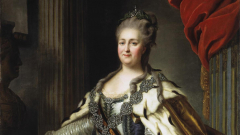The modern-day idea of political disinformation has roots in the story of a Russian leader’s tour of Ukraine. But the tale from history is not to be trusted.

Once upon a time, there lived a powerful leader known as Catherine the Great who ruled a vast empire and, over the years, conquered many new lands.
Catherine appointed her boyfriend to oversee one of those conquests — a place now called Ukraine. As time passed, he informed her the citizens were flourishing and happy. But, according to a version of the tale passed on for centuries, it was a lie.
In the legend, Catherine decided to launch an expedition, taking a barge down the Dnieper River so she could observe the thriving, joyful subjects. Her boyfriend, Grigory, was fearful his deceit would be exposed, and eager to please his beloved. So, the story goes, he instructed minions to build fake villages along the riverfront — freshly painted facades.
The expedition, with thousands of soldiers and servants, proceeded for six months. According to popular accounts, after Catherine passed each village, the fake buildings were disassembled, placed on carts, rushed downriver and re-created for another viewing.
Catherine, in the story, was mesmerized by the achievements of her lover, Grigory Potemkin, rewarding him with an appointment as Prince of Tauris (Crimea). And, to this day, people worldwide still refer to fake news and false fronts using his name: “Potemkin villages.”
Over hundreds of years, the insult came to be used for almost any alleged sham, from China’s green energy program to former President Obama’s gun control efforts or former President Trump’s coronavirus response.
More recently, as Ukrainian defenses held off Russia’s military invasion, pundits scoffed that Vladimir Putin was duped by his “Potemkin military,” whose leaders misrepresented the war outlook. When Putin tried to prop up Russia’s economy amid international sanctions, U.S. officials talked of Moscow’s “Potemkin market.” And, after Russia offered to end the war in return for control of southern Ukraine, critics ridiculed the notion of a “Potemkin peace.”
But history and politics are a tangle of lies and intrigue, especially in Russia, so there is a twist to this tale:
There were no fake villages. Potemkin did not scam Catherine II with props. In fact, researchers say his accomplishments in Ukraine were authentic, and popular claims to the contrary are fiction — a smear spewed by Russian rivals at the time and forever seared into belief and vernacular.
“The very concept of ‘Potemkin village’ is a Potemkin village,” said Simon Sebag Montefiore, author of “Catherine the Great & Potemkin: Power Love & Russian Empire.” “Totally false, a libel without a shred of truth.”
While the legend may be bogus, Sebag Montefiore and other historians believe the Crimea expedition and Potemkin’s fable remain at the heart of today’s conflict in Ukraine. Put simply, they contend, thousands have been killed and millions displaced in a war based on Putin’s misrepresentation of that history.
Marvin Kalb, a Harvard professor emeritus and former journalist who wrote “Imperial Gamble” after Russia’s 2014 invasion of Crimea, suggested the bloody conflict is a product of disinformation, much like the lie that has haunted Catherine’s expedition for 235 years.
“The relevance of that story today is that Putin is creating a Potemkin village in the way he describes his war,” Kalb said. “And the deception is overwhelming.”
The real tour of Potemkin’s villages
There is no question that Potemkin took Catherine on a tour through towns that were decorated for royal visitors.
But historical consensus is clear that the prince’s dramatic developments were real. Proof rests in Russian archives, diaries and letters penned by those who took part in the 4,000-mile expedition.
Catherine, who projected an image of enlightenment royalty, corresponded daily with her subjects and heirs in a literary style reminiscent of “Pride and Prejudice.”
It is fair to ask how this woman, a German-born princess, wound up as a Russian empress. The answer: a wedding. Catherine married Peter III, portrayed by history as a hapless emperor lacking in leadership skills as well as spousal affection.
Thus, in 1762, Catherine conspired with other royals and military officers to stage a coup.
Peter, caught off guard, abdicated the throne and was killed soon thereafter.
Potemkin, among those who aided Catherine, became her paramour and swiftly ascended to military commander and viceroy over half the Russian empire.
At a time when American colonists were fighting for independence from England, Potemkin led Russia’s conquest of the steppes and Crimea, defeating Ottoman sultans and Tatar khans. He successfully pressed Catherine to annex the territory of what is now southern Ukraine, writing, “Believe me, with this acquisition you will achieve immortal glory such that no other Sovereign in Russia has ever had.”
With Catherine’s support, Potemkin rapidly developed the territory dubbed Novorossiya (New Russia). Greeks, Slavs, Poles, Jews, Italians and others were imported to till the land, build shipyards, erect forts. Cities were founded, including Mariupol, Dnipro and Odesa — places now emblematic of Russian military aggression and alleged war crimes.
Maps: Tracking Russia’s invasion of Ukraine
OnPolitics: Why is Putin declaring victory in Mariupol?
By 1787, Potemkin was ready to display Russia’s new colony to the empress. And Catherine welcomed an opportunity to survey the conquest while flaunting her power.
Catherine the Great’s tour of Crimea
The entourage first traveled by land through snow and bitter cold from St. Petersburg to Kyiv.
In “Catherine the Great: Love, Sex and Power,” biographer Virginia Rounding describes an ensemble with 14 enormous carriages and 124 sleighs. The empress’ coach, pulled by 30 steeds, boasted a bedroom, office and library.
As the spectacle passed through towns, residents came outside to ogle. During overnight stops, Catherine sponsored lavish feasts with balls and fireworks displays.
After three weeks, the parade pulled into Kyiv and was joined by Potemkin. Catherine held court and threw more parties for two months.
As Dnieper River ice melted and waters rose, Rounding recounts, the entourage loaded onto “seven gold and scarlet galleys,” each with its own orchestra. The ships were accompanied by a dining barge and 80 other vessels containing 3,000 troops. There was even a 252-foot-long “vermicular” — an experimental boat powered by 120 oarsmen.
“Cities, villages, homesteads and sometimes simple huts were so decorated with flowers, painted decorations and triumphal gates that their appearance was deceiving the eyes,” wrote Louis Philippe, comte de Segur, one of many guests on the sojourn.
Cannons were fired upon the flotilla’s arrival at each town but, as another traveler wrote at the time, no announcement was necessary: “Along the riverbanks, a crowd of onlookers, constantly renewing itself, came from all corners of the empire to admire the progress of our courtege.”
Rounding’s history adds: “All the villages and houses they passed were decked with flowers and triumphal arches (which is what may have given rise to the myth that Potemkin had built pretend villages and towns.)”
By all accounts, Catherine — who was 60 at the time of the voyage – maintained a revolving door for young lovers, but Potemkin was favored, and most important to her rule.
Sebag Montefiore describes the couple as “the most successful male and female political team in world history.” Their letters, he adds, simultaneously reflect a sensual love affair and “a study in power.”
The expedition concluded at the Bay of Sevastopol on the Black Sea, where Potemkin showed off his new Russian Navy fleet and spelled out the empress’ name with fireworks.
How ‘Potemkin’ came to mean propaganda
Not all Russians were enamored.
According to Sebag Montefiore, rivals in the Russian court at St. Petersburg – “including Catherine’s embittered and excluded half-mad son, Paul” – fabricated the village myth to sabotage Potemkin.
Their smear campaign, in turn, was advanced by enemies of Russia’s western expansion, including England and Prussia, giving the Potemkin village story global reach.
In his biography of Catherine, historian Robert K. Massie wrote that the expedition is still regarded by some as “the most remarkable journey ever made by a reigning monarch — and as Gregory Potemkin’s greatest public triumph.” As a result, he added, Potemkin, became “the most powerful man in Russia.”
Those who questioned or mocked the trip did not take part in it, Massie noted. Moreover, Potemkin’s accomplishments were verified not just by Catherine, but by “sharp-eyed and sophisticated foreigners,” including the emperor of Austria, a prince and France’s ambassador.
“Over two centuries,” Massie concluded, “no one has produced any evidence that what these three said and wrote about their journey was untrue.”
Yet Potemkin’s name today, if it’s recognized at all, is synonymous with propaganda.
Which brings us back to Putin.





